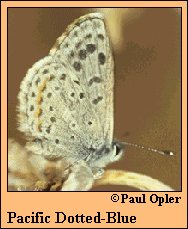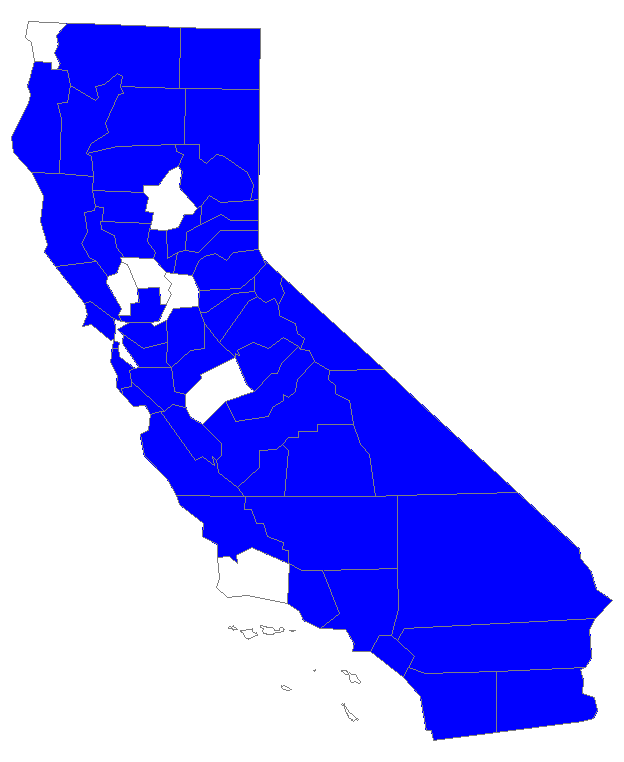 |
 

 |



Pacific Dotted-Blue (Euphilotes enoptes [Boisduval])
Wing span: 3/4 - 7/8 inches (1.8 - 2.3 cm).
Identification: Geographically variable. Upperside of male is lilac blue with dark borders; female is brown usually with an orange patch on margin of hindwing. Underside of both sexes is off-white with black spots. Those of forewing larger and more squarish than those of hindwing. Orange band on hindwing usually broken into separate spots.
Life history: Dotted-Blues usually stay near their host plants. Males patrol around the host plants all day to find females. Eggs are laid singly on flowers or buds; caterpillars eat flowers and fruits and are tended by ants. Chrysalids hibernate in leaf litter.
Flight: One flight from mid-May to October depending on host and location.
Caterpillar hosts: Various Eriogonum species including Nude Buckwheat, Wright's Buckwheat, Inflated Buckwheat, and others.
Adult food: Flower nectar, especially from Eriogonum.
Habitat: Sun-exposed rocky or sandy flats or slopes in foothills, mountains, desert, and along coast.
Range: Scattered distribution throughout the western United States from Washington south through Pacific Coast states to northern Baja California. Also Nevada and northwest Arizona.
Conservation: Smith's dotted-blue, Euphilotes enoptes smithi, is endangered because its California coastal habitat is being damaged by increased human activity including housing developments, recreation, and sand mining. Its status in complicated because of the recent description of subspecies arenacola Emmel, Emmel, and Pratt for part of its distribution. Other subspecies from more interior locations may be threatened by invasion of exotic cheatgrass and the eventual fires that often result from such invasion.
The Nature Conservancy Global Rank: G5 - Demonstrably secure globally, though it may be quite rare in parts of its range, especially at the periphery. Smith's dotted-blue has The Nature Conservancy rank of T1,T2 - Imperiled because of rarity (6 to 20 occurrences), or because of other factors demonstrably making it very vulnerable to extinction throughout its range. (Endangered throughout its range). Other recently described subspecies have ranks of T1.
Management needs: Conserve habitats for Smith's blue and maintain host plant populations. Determine conservation status of other subspecies.
References:
Emmel, T.C., editor. 1998. Systematics of Western North American Butterflies.
Mariposa Press, Gainesville, Fla. 878 pp.
Emmel, T.C. and J.F. Emmel. 1973. The butterflies of southern California. Natural
History Museum of Los Angeles County, Los Angeles. 148 pages.
Garth, J.S. and J.W. Tilden. 1986.California Butterflies. University of California
Press, Berkeley and Los Angeles. 246 pp, 24 plates.
Matthews, J. R., editor. 1990. The official World Wildlife Fund guide to endangered
species of North America, Vol. 2. Beacham Publishing, Inc., Washington, D. C.
636 pages.
Opler, P.A. 1999. A field guide to western butterflies. Houghton-Mifflin Co.,
Boston, Mass. 540 pages, 44 color plates.
Scott, J. A. 1986. The butterflies of North America. Stanford University Press,
Stanford, Calif. 583 pages, 64 color plates.
Stanford, R. E. and P. A. Opler. 1993. Atlas of western USA butterflies including
adjacent parts of Canada and Mexico. Denver and Fort Collins, CO.
Author: Paul A. Opler
State and Regional References:
Brown, J.W., Real, H.G., and D.K. Faulkner. 1992. Butterflies of Baja
California. Lepidoptera Research Foundation, Beverly Hills, Calif.
Comstock, J.A. 1927. Butterflies of California. Privately published, Los
Angeles, Calif. [Facsimile available from Entomological Reprint
Specialists, Los Angeles, Calif.]
Dameron, W. 1997. Searching for butterflies in southern California.
Flutterby Press, Los Angeles, Calif.
Emmel, T.C. Editor. 1998. Systematics of western North American butterflies.
Mariposa Press, Gainesville, Florida.
Emmel, T. C. and J. F. Emmel. 1973. The Butterflies of Southern California.
Natural History Museum of Los Angeles County Science Series No. 26.
Garth, J.S. and J.W. Tilden. 1986. California Butterflies. California Natural
History Guide 51. University of California Press, Berkeley and Los
Angeles.
Langston, R.L. 1981. The Rhopalocera of Santa Cruz Island, California. Journal
of Research on the Lepidoptera 18: 24-35.
Miller, Scott E. 1985. Butterflies of the Califorenia Channel Islands. Journal
of the Research on the Lepidoptera 23: 282-296.
Opler, Paul A. 1999. Peterson Field Guide to Western Butterflies, revised
edition. Houghton Mifflin Co., Boston, Mass.
Orsak, L.J. 1977. The Butterflies of Orange County, California. Museum of
Systematic Biology, University of california, Irvine.
Stanford, R.E. and P.A. Opler. 1993. Atlas of Western USA Butterflies.
Privately published, Denver, Colo.
Steiner, J. 1990. Bay Area Butterflies: The Distribution and Natural History
of San Francisco Region Rhopalocera. Hayward, Calif.: Hayward State
University, Masters Thesis.
Tilden, J.W. and A.C. Smith. 1986. A Field Guide to Western Butterflies.
Houghton Mifflin Co., Boston, Mass.
Tilden, J.W. 1965. Butterflies of the San Francisco Bay Region. California
Natural History Guide 12. University of California Press, Berkeley and
Los Angeles.

